Coastal Retreat on the Spanish Mediterranean Coast in a Climate Change Context: Effects of the Regulation of the Segura River at Its Mouth and the Coastal Sand Dune in Guardamar del Segura (Alicante, Spain)
Abstract
:1. Introduction
- (a)
- To analyse the regulation works on the Segura River Basin with the reduction of average and extraordinary flows.
- (b)
- To analyse the coastal retreat experienced between 1929 and 2023 on the coast of Guardamar del Segura, specifically the problem of Babilonia Beach.
- (c)
- To analyse sea currents, waves and winds.
- (d)
- To make proposals for the recovery or reduction of coastal retreat in the sector of Guardamar del Segura.
2. Materials and Methods
2.1. Study Area
2.2. Methodology
3. Results
3.1. Major Regulation Works in the Segura Basin and the Reduction of Ordinary Average Flows and Extraordinary Maximum Flows
3.2. Evolution of the Coastal Retreat Process in the Coastal Area of Guardamar del Segura as a Result of the Anthropogenic Actions in the Segura Basin and the Coastal Space
3.3. Dominant Winds, Waves and Marine Currents
4. Discussion
- They use data from the gauging station closest to Santa Pola, applying them to the mouth of the Segura River. As shown in the results section, the sea swell in the vicinity of Santa Pola is SSE, while in the area between and the mouth of the Segura River and Torrevieja, there is a predominantly ENE and E swell. Therefore, the placement of the breakwater should cover the SSE waves, which is incorrect.
- The data used for the sea swell are based on 1751 observations. If each individual figure is understood as a day, it represents a time period of almost five years, which is insufficient for decision-making. In the results section of the current study, long series were used from 1953 to 2023, which reveal the real behaviour of the waves.
- They consider the coastal drift to have an S–N direction, as it accumulates a greater volume of sediment towards the north. However, this interpretation of the data is incorrect, given that the greatest volume of sediment is found in the vicinity of the mouth of the Segura River, on its southern bank, and the further we move in this direction, the more we can observe a gradually greater reduction in the amount of materials. This justifies the distribution of materials via an N–S coastal drift from the mouth of the river to Torrevieja, which is the furthest point and is, therefore, where there is less sediment. Meanwhile, the materials deposited on the northern bank of the Segura River from S to N increase, but this is due to the waves from the SSE, as observed in the results section. Recent studies have shown that the dominant direction of the sea swell is NE, favouring the N–S coastal drift [49,71]. In fact, if the coastal drift were S–N, as indicated by CEDEX, after the construction of the breakwater, the beaches of Guardamar del Segura would have grown after more than 25 years in operation and would not have experienced a retreat process, which was shown in the results section of the current study with the evolution of the coastline from 1929 to 2023.
- The final justification of the CEDEX study is that the placement of the breakwaters prevents the accumulation of materials in the mouth of the Segura River. This aspect has not been resolved, given that the sediment accumulates inside the breakwaters as its discharge from the river waters is hindered by the presence of the inverted breakwater, acting as a dam. This means that dredging actions have to be undertaken in the yachting harbour and the new and old courses of the Segura River. This situation also increases the difficulty of the flood waters of the Segura River in discharging, exponentially heightening the flood risk.
- To all of this we should add a further problem: Between 1996 and 1999, the Guardamar yachting harbour was built inside the course of the Segura River in a former area of salt marshes. In order to construct it, 200,000 m3 of slurry was extracted and immediately deposited in the dune system, causing severe environmental damage and further aggravating the natural dynamics of the dune system [30,49,72]. The dumping of these slurries was halted by the Prosecutor’s Office for Environmental Crimes of the Provincial Court of Alicante [30,72]. Between 2002 and 2011, attempts were made to eliminate the anthropogenic materials that had been dumped [49].
- The final result of all of these actions is the following negative effects: On the one hand is the channelling of the Segura River by way of the construction of an artificial canal that breaks the dynamics of the dune system of Guardamar del Segura in relation to its northern and southern coast. On the other hand are the long-existing and inverted breakwaters that break the dominant coastal drift (NE–SW), which enable the distribution of sediment in the coastal areas, favouring beach accretion processes in the coastal sector. This justifies the erosion–regression that exists in the area of study, particularly on the right bank of the mouth of the Segura River [30].
- To increase the ecological flows with geomorphological patterns, enabling an increase in the transport of sediment from the river to its mouth. This action is, in any event, complicated within the context of climate change and the reduction of flows already recorded in the Segura River.
- To eliminate some of the control dams in order to enable the input of sediment in the mid and lower sections of the Segura River. This action would require an economic feasibility study in order to evaluate the pros and cons in terms of the impact that it would have on the territory in the event of torrential rains and the flooding of the affected river courses.
- To recover and restore the Segura River, eliminating the retaining walls built after the flood of November 1987 and the development, in the following years of the Segura Basin Flood-Defence Plan.
- To completely eliminate the channelling of the old and new courses of the Segura River in its final stage in the Municipality of Guardamar del Segura and to eliminate the wall separating the old and new courses.
- To completely remove the breakwaters at the mouth of the Segura River or construct a breakwater placed to protect from ENE and E storms, such as the one occurring in 1987 before the flood.
- In agreement with the concessionaires, to demolish the houses on Babilonia Beach and apply bioengineering techniques or nature-based solutions to protect the coast from offshore storms and to favour a greater accumulation of sediment and the recovery of the dune system. This is a controversial measure due to the assumption of the “ownership” rights among the concessionaires of the occupation of the maritime–terrestrial public domain, hence the need for the central and local administrations to reach agreements with the concessionaires to offer them land further inland in the municipality, where they can build new houses under feasible financial conditions. In the worst-case scenario, if an agreement is not reached between the administration and the concessionaires, the Climate Change Law (2021) (Art. 20) would open the door for the withdrawal of concessionary rights, in compliance with the Coast Law of 1988 and the non-renewal of them in cases where the effects of climate change on the territories’ object of administrative concession are evident. This aspect was ratified in the modification of the Coastal Regulation of 2020 (RD 668/2022) [74].
5. Conclusions
Author Contributions
Funding
Institutional Review Board Statement
Informed Consent Statement
Data Availability Statement
Conflicts of Interest
References
- Pilkey, O.P.; Dixon, K. The Shore and the Corps; Island Press: Washington, DC, USA, 1996; pp. 1–272. [Google Scholar]
- Kopp, R.E.; Horton, R.M.; Little, C.M.; Mitrovica, J.X.; Oppenheimer, M.; Rasmussen, D.D.; Strauss, B.H.; Tebaldi, C. Probabilistic 21st and 22nd century sea-level projections at a global network of tide-gauge sites. Earth’s Future 2014, 2, 383–406. [Google Scholar] [CrossRef]
- Watson, C.S.; White, N.J.; Church, J.A.; King, M.A.; Burgette, R.J.; Legresy, B. Unabated global mean sea-level rise over the satellite altimeter era. Nat. Clim. Change 2015, 5, 565–568. [Google Scholar] [CrossRef]
- Join Research Center (JRC). PESETA III–Task 8. Coastal Impacts. Available online: https://joint-research-centre.ec.europa.eu/peseta-projects/peseta-iii_en (accessed on 20 November 2023).
- Intergovernmental Panel on Climate Change. Special Report on the Ocean and Cryosphere in a Changing Climate (Full Report). Available online: https://www.ipcc.ch/srocc/ (accessed on 20 November 2023).
- IPCC. AR6 Climate Change 2021–2022: The Physical Science Basis, Impacts, Adaptation and Vulnerability. Mitigation of Climate Change (Full Report). Available online: https://www.ipcc.ch/reports/ (accessed on 20 November 2023).
- Minunno, R.; Anderson, N.; Morrison, G.M. A systematic literature review considering the implementation of planetary geoengineering techniques for the mitigation of sea-level rise. Earth-Sci. Rev. 2023, 241, 104431. [Google Scholar] [CrossRef]
- JRC. PESETA IV–Task 6. Adopting to Rising Coastal Flood Risk in the EU under Climate Change; Publicaciones Office of the European Union: Luxemburg, 2020. [Google Scholar] [CrossRef]
- Wang, H.; Wu, X.; Bi, N.; Li, S.; Yuan, P.; Wang, A.; Syvitski, J.P.M.; Saito, Y.; Yang, Z.; Liu, S.; et al. Impacts of the dam-oriented water-sediment regulation scheme on the lower reaches and delta of the Yellow river (Huanghe): A review. Glob. Planet. Change 2017, 157, 93–113. [Google Scholar] [CrossRef]
- Batalla, R.J.; Vericat, D.; Farguel, J.; Úbeda, X.; Garcia, C. Processsos hidrològics I geomorfològics als rius: Context i exemples per a interpreter la seva resposta a episodis d’alta magnitude como el Glòria. Treb. Soc. Catalana Geogr. 2020, 89, 55–87. [Google Scholar] [CrossRef]
- Blay, J.; Ávila, A. Els efectes del temporal Glòria: Una mostra de la necessitate d’actuació urgent al delta de l’Ebre. Treb. Soc. Catalana Geogr. 2020, 163–189. [Google Scholar] [CrossRef]
- Nilsson, C.; Reidy, C.A.; Dynesius, M.; Revenga, C. Fragmentation and flow regulation of the world’s large river system. Science 2005, 308, 405–408. [Google Scholar] [CrossRef] [PubMed]
- Vörösmarty, C.; Meybeck, M.; Fekete, B.; Sharma, K.; Green, P.; Syvitski, J.P.M. Anthropogenic sediment retention: Major global impact from registered river impoundments. Glob. Anb Planet. Change 2003, 39, 169–190. [Google Scholar] [CrossRef]
- Giosan, L.; Constantinescu, S.; Syvitski, J.; Day, J.W. Climate Change: Protect the world’s deltas. Nature 2014, 516, 31–33. [Google Scholar] [CrossRef] [PubMed]
- Ibisate González de Matauco, A. Variación del riesgo de inundaciones en el río Zadorra (País Vasco) como consecuencia de su regulación. Investig. Geográficas 2005, 36, 119–133. [Google Scholar] [CrossRef]
- García Ruiz, J.M.; Lana-Renault, N.; Beguería, S.; Lasanta, T.; Regüés, D.; Nadal, E.; Serrano, P.; López Moreno, J.I.; Alvera, B.; Martí Bono, C.; et al. From plot to regional scales: Interactions of slope and catchment hydrological and geomorphic processes in the Spanish Pyrenees. Geomorphology 2011, 120, 248–257. [Google Scholar] [CrossRef]
- He, A.; Huang, J.; Sun, Z.; Zhou, J.; Yang, C. Spatial and Temporal evolution characteristics of the Salween river delta from 1973 to 2021. Remote Sens. 2023, 15, 1467. [Google Scholar] [CrossRef]
- Prats-Puntí, A.; Martín Vide, J.P.; Ferrer-Boix, C. Regressió del Delta del Llobregat. Efecte de les Obres d’Enginyeria al Riu d’Ençà del Segle XIX; Cuadernos de Geografía de la Universitat de Valencia: Valencia, Spain, 2021; p. 107. [Google Scholar]
- García Ruiz, J.M.; López Moreno, J.I.; Lasanta, T.; Vicente, S.M.; González Sampériz, P.; Valero, B.L.; Sanjuán, Y.; Beguería, S.; Nadal, E.; Lana-Renault, N.; et al. Los efectos geoecológicos del cambio global en el Pirineo central español: Una revisión a distintas escalas espaciales y temporales. Pirineos. Rev. Ecol. Montaña 2015, 170, 1–20. [Google Scholar] [CrossRef]
- Conesa, C. Cambio ambiental y equilibrio dinámico de los cauces. Papeles Geogr. 1999, 30, 31–46. [Google Scholar]
- Ollero, A.; Ibisate, A.; Granado, D.; Real de Asua, R. Channel responses to global change and local impacts: Perspectives and tools for floodplain management (Ebro River and tributaries, NE Spain). In Geomorphic Approaches to Integrated Floodplain Management of Lowland Fluvial Systems in North America and Europe; Hudson, P.F., Middelkoop, H., Eds.; Springer: New York, NY, USA, 2015; pp. 27–52. [Google Scholar]
- Vázquez-Tarrío, D.; Ruiz-Villanueva, V.; Garrote, J.; Benito, G.; Calle, M.; Lucía, A.; Díez-Herrero, A. Effects of sediment transport on flood hazards: Lessons learned and remaining challenges. Geomorfology 2023, 446, 108976. [Google Scholar] [CrossRef]
- Gallegos, A.; Perles, M.J. Relaciones entre los cambios en los usos del suelo y el incremento de los riesgos de inundabilidad y erosión: Análisis diacrónico en la provincia de Málaga (1957–2007). Bol. Asoc. Geógr. Esp. 2019, 81, 1–38. [Google Scholar] [CrossRef]
- Ollero, A.; Ibisate, A.; Acín, V.; Ballarín, D.; Granado, D.; Horacio, J.; Mora, D.; Nadal, E.; Sánchez Fabre, M.; Sebastián, M.; et al. Dynamique fluviale, changement global et pression anthropique dans le bassin, le cours et le delta de l’Èbre. Sud-Ouest Eur. 2017, 44, 41–54. [Google Scholar] [CrossRef]
- Kondolf, G.M. Hungry water: Effects of dams and gravel mining on river channels. Environ. Manag. 1997, 21, 533–551. [Google Scholar] [CrossRef] [PubMed]
- Surian, N. y Rinaldi, M. Morphological response to river engineering and management in alluvial channels in Italy. Geomorphology 2003, 50, 307–326. [Google Scholar] [CrossRef]
- Martín Vide, J.P.; Ferrer-Boix, C.; Ollero, A. Incision due to gravel mining: Modeling a case study from the Gállego River, Spain. Geomorphology 2010, 117, 261–271. [Google Scholar] [CrossRef]
- Ferrer-Boix, C.; Scorpio, V.; Martín Vide, J.P.; Núñez, F.; Mora, D. Massive incision and outcropping of bedrock in a former braided river attributed to mining and training. Geomorphology 2023, 436, 108774. [Google Scholar] [CrossRef]
- Daramola, S.; Li, H.; Omonigbehin, O.; Faruwa, A.; Gong, Z. Recent retreat and flood dominant areas along the muddy Mahin coastline of Ilaje, Nigeria. Reg. Stud. Mar. Sci. 2022, 52, 102272. [Google Scholar] [CrossRef]
- Matarredona Coll, E.; Marco Molina, J.A.; Prieto Cerdán, A. La configuración física del litoral sur alicantino. Geografía Física y Medio Ambiente. Guía Campo XXI J. Geogr. Física 2006, 1, 35–47. [Google Scholar]
- Doyle, T.B.; Short, A.D.; Ruggiero, P.; Woodroffe, C.D. Interdecadal foredune changes along the southeast Australian coastline: 1942–2014. J. Mar. Sci. Eng. 2019, 7, 177. [Google Scholar] [CrossRef]
- Sanjosé Blasco, J.J.; Serrano-Cañadas, E.; Sánchez-Fernández, M.; Gómez-Lende, M.; Redweik, P. Application of multiple geomatic techniques for coastline retreat analysis: The case of Gerra Beach (Cantabrian Coast, Spain). Remote Sens. 2020, 12, 3669. [Google Scholar] [CrossRef]
- Sui, L.; Wang, J.; Yang, X.; Wang, Z. Spatial-Temporal characteristics of Coastline Changes in Indonesia from 1990 to 2018. Sustainability 2020, 12, 3242. [Google Scholar] [CrossRef]
- Ministerio de Medio Ambiente (MMA). Impactos en la Costa Española por Efecto del Cambio Climático. Fase III. Estrategias Frente al Cambio Climático en la Costa, 1st ed.; Dirección General de Calidad y Evaluación Ambiental y Universidad de Cantabria: Madrid, Spain, 2004; pp. 1–132. [Google Scholar]
- Ministerio de Agricultura, Alimentación y Medio Ambiente (MAGRAMA). Cambio Climático en la Costa Española, 2nd ed.; Ministerio de Agricultura, Alimentación y Medio Ambiente: Madrid, Spain, 2014; pp. 1–132. [Google Scholar]
- Ministerio para la Transición Ecológica y Reto Demográfico (MITERD). Plan Nacional de Adaptación al Cambio Climático (PNACC); Ministerio para la Transición Ecológica y Reto Demográfico: Madrid, Spain, 2020; pp. 1–246. [Google Scholar]
- MITERD. En España Existen 1.200 Grandes Presas. Available online: https://hispagua.cedex.es/documentacion/noticia/38552 (accessed on 20 November 2023).
- Oliva Cañizares, A.; Olcina Cantos, J. Temporales marítimos, cambio climático y cartografía de detalle de ocupación de la franja costera: Diagnóstico en el sur de la provincia de Alicante (España). Doc. D’Anàlisi Geogràfica 2022, 68, 107–138. [Google Scholar] [CrossRef]
- Puig, M.; Montes, J.; Río, L.; Benavente, J.; Gracia, F.J. Costa gaditana: Esos temibles temporales costeros. Enseñanzas Cienc. Tierra 2017, 25, 247–249. [Google Scholar]
- Ollero, A.; Ibisate, A.; Acín, V.; Ballarín, D.; Besne, P.; Díaz, E.; Ferrer-Boix, C.; Granado, D.; Herrero, X.; Horacio, J.; et al. Geomorfología y restauración fluvial: Seguimiento del derribo de presas en Guipúzcoa. Cuad. Investig. Geográfica 2014, 40, 67–88. [Google Scholar] [CrossRef]
- Rodríguez, I.; Santillán, J.I.; Huertas, R. Excursión del I Congreso Ibérico de restauración fluvial. In Actas del I Congreso Ibérico de Restauración Fluvial Restauraríos; Centro Ibérico de Restauración Fluvial, Ministerio de Medio Ambiente y Medio Rural y Marino y Confederación Hidrográfica del Duero: León, Spain, 2011; pp. 891–895. [Google Scholar]
- Álvarez, F.; San Emeterio, D.; Tames, P. Criterios de Diseño de las Actuaciones en Obstáculos Realizadas por la Diputación Foral de Guipúzcoa. In Actas del I Congreso Ibérico de Restauración Fluvial Restauraríos; Centro Ibérico de Restauración Fluvial, Ministerio de Medio Ambiente y Medio Rural y Marino y Confederación Hidrográfica del Duero: León, Spain, 2011; pp. 397–404. [Google Scholar]
- Ibisate, A.; Ollero, A.; Ballarín, D.; Horacio, J.; Mora, D.; Mesanza, A.; Ferrer-Boix, C.; Acín, V.; Granado, D.; Martín-Vide, J.P. Geomorphic monitoring and response to two dam removals: Urumea and Leitzaran Rivers (Basque Country, Spain). Earth Surf. Process. Landf. 2016, 41, 2239–2255. [Google Scholar] [CrossRef]
- Prieto, F.; Navarro-Jurado, E. Desarrollo litoral sostenible en España: Proceso de litoralización (1960–2012). Tipificación de municipios y escenarios para 2030. Destrucción de un bien común y pérdida de los servicios de los ecosistemas. Lecciones aprendidas pensando en latino-América. La tragedia de los comunes en la costa española. In Libro de Comunicaciones y Pósteres. I Congreso Iberoamericano de Gestión Integrada de Áreas Litorales; Barragán Muñoz, J.M., Ed.; Universidad de Cádiz: Cádiz, Spain, 2012; pp. 133–152. [Google Scholar]
- Ministerio de Agricultura, Pesca y Alimentación. Demografía de la Población Costera en 2020. Análisis y Prospectiva. 2022. Available online: https://www.mapa.gob.es/es/ministerio/servicios/analisis-y-prospectiva/aypseriepesca5_demografiapoblacioncostera2020_tcm30-617441.pdf (accessed on 20 November 2023).
- Olcina Cantos, J.; Saurí, D.; Hernández, M.; Ribas, A. Flood Policy in Spain: A review for the period 1983–2013. Disaster Prev. Manag. 2016, 25, 41–58. [Google Scholar] [CrossRef]
- Olcina Cantos, J. Cambio climático y riesgos climáticos en España. Investig. Geográficas 2009, 49, 197–220. [Google Scholar] [CrossRef]
- Segura Hidrografic Confederation (CHS). Plan Hidrológico de la Cuenca del Segura (2022–2027). Available online: https://www.chsegura.es/es/cuenca/caracterizacion/marco-fisico/ (accessed on 20 November 2023).
- Fernández-Hernández, M.; Calvo, A.; Iglesias, L.; Castedo, R.; Ortega, J.J.; Díaz-Honrubia, A.J.; Mora, P.; Costamagna, E. Anthropic action on historical shoreline changes and future estimates using GIS: Guardamar del Segura (Spain). Appl. Sci. 2023, 13, 9792. [Google Scholar] [CrossRef]
- Segura Hidrografic Confederation (CHS). Visor CHS. Available online: https://www.chsegura.es/portalchsic/apps/webappviewer/index.html?id=893ec33b6ba84fc09102663dce94b740&codif=&nombre=Basico (accessed on 20 November 2023).
- Valencian Cartographic Institute (ICV). Fototeca. Available online: https://geofototeca.gva.es/visor_fototeca/ (accessed on 20 November 2023).
- National Geographic Institute (IGN). Servicios WMS. Available online: https://www.ign.es/web/ign/portal (accessed on 20 November 2023).
- Valencian Cartographic Institute (ICV). Visor GVA. Available online: https://visor.gva.es/visor/?idioma=es (accessed on 20 November 2023).
- Puertos del Estado. Available online: https://www.puertos.es/es-es (accessed on 13 October 2023).
- Calvo García-Tornel, F. Las transformaciones de los espacios urbanos fluviales en zonas áridas: Lecciones de la cuenca del Segura. Doc. D’Anàlisi Geogràfic 1997, 31, 103–116. [Google Scholar]
- Gil Olcina, A.; Canales Martínez, G. Concausas y Tipos de Inundaciones en la Vega Baja del Segura; Universidad de Alicante: San Vicente del Raspeig, Spain, 2022; pp. 1–472. [Google Scholar]
- Morote Seguido, A.F.; Rico Amorós, A.M. Perspectivas de funcionamiento del trasvase Tajo-Segura (España): Efectos de las nuevas reglas de explotación e impulso de la desalinización com recurso sustitutivo. Bol. Asoc. Geógr. Esp. 2018, 79, 1–43. [Google Scholar] [CrossRef]
- Vericat, D.; Batalla, R.J. Sediment transport in a large impounded river: The lower Ebro, NE Iberian Peninsula. Geomorphology 2006, 79, 72–92. [Google Scholar] [CrossRef]
- Benahmed, Z. Disseny d’un Sistema de Mostreig del Transport de Sediment de Fons a Rius amb Helley-Smith; Universitat Politècnica de Catalunya: Barcelona, Spain, 2021. [Google Scholar]
- Lobera, G.; Batalla, R.J.; Vericat, D.; López Tarazón, J.A.; Tena, A. Sediment transport in two mediterranean regulated rivers. Sci. Total Environ. 2016, 540, 101–113. [Google Scholar] [CrossRef] [PubMed]
- Horacio, J.; Ibisate, A.; Sánchez Pinto, I.; Beltrán de Lubiano, J.; Ollero, A. Seguimiento del transporte de sedimentos mediante trazadores en el río Leitzaran. In Geomorfología del “Antropoceno”: Efectos del Cambio Global Sobre los Procesos Geomorfológicos; Garcia, C., Gómez-Pujol, L., Morán-Tejeda, E., Batalla, R.J., Eds.; Universitat de les Illes Balears: Mallorca, Spain, 2018; pp. 53–56. [Google Scholar]
- Piégay, H.; Arnaud, F.; Cassel, M.; Dépret, T.; Alber, A.; Michel, K.; Rollet, A.J.; Vaudor, L. Suivi par RFID de la mobilité des galets: Retour sur 10 ans d’expérience en grandes rivières. Bull. Soc. Géogr. Liège 2016, 67, 77–91. [Google Scholar]
- Vázquez Tarrío, D.; Batalla, R.J. Assessing controls on the displacement of tracers in gravel-bed rivers. Water 2019, 11, 1598. [Google Scholar] [CrossRef]
- Arnaud, F.; Paquier, A.; Vázquez-Tarrío, D.; Camenen, B.; Le Coz, J.; Michel, K.; Naudet, G.; Pella, H.; Piégay, H. Comparing field, probabilistic, and 2D numerical approaches to assess gravel mobility in a gravel-bed river. Water Resour. Res. 2023, 59, e2022WR034127. [Google Scholar] [CrossRef]
- Braud, S.; Alber, A. Synthèses des Connaissances et Proposition D’une Méthode D’évaluation de L’impact des Ouvrages Transversaux sur la Continuité Sédimentaire des Cours D’eau; Direction Régionale de l’Environnement de l’Aménagement et du Logement Centre: Poiters, France, 2013; pp. 1–76. [Google Scholar]
- Ibáñez, C.; Prat, N.; Canicio, A. Changes in the hydrology and sediment transport produced by large dams on the lower Ebro river and its estuary. Regul. Rivers Res. Manag. 1996, 12, 51–62. [Google Scholar] [CrossRef]
- Vericat, D.; Church, M.; Batalla, R.J. Bed load bias: Comparison of measurements obtained using two (76 and 152 mm) Helley-Smith samplers in a gravel bed river. Water Resour. Res. 2006, 42, W01402. [Google Scholar] [CrossRef]
- Gorostiza, S.; Parrinello, G.; Aguettaz, D.; Saurí, D. Where have all the sediments gone? Reservoir silting and sedimentary justice in the lower Ebro River. Political Geogr. 2023, 107, 102975. [Google Scholar] [CrossRef]
- Mariano, M.; Abella, S.; Araujo, R.; Ibisate, A.; Ollero, A. Nature-human-river relationships at the Ebro River and its Delta (Spain). In River Culture–Life as a Dance to the Rhythm of the Waters; Wantzen, K.M., Ed.; UNESCO Publishing: Paris, France, 2023; pp. 745–782. [Google Scholar]
- Ollero, A. Los paisajes fluviales peninsulares en un contexto de cambio hidroclimático ambiental: Los retos de la gestión de riesgos y de la restauración. In El Bajo Segura como Enclave Hidrológico: Territorio, Economía y Paisaje; Zaragoza, M.F., Ed.; Tirant Humanidades: Valencia, Spain, 2023; pp. 287–318. [Google Scholar]
- Peña, L.; Onaindia, M.; Muñoz, O.; Amaya, A.; Fernández de Manuel, B.; Ametzaga-Arregi, I. Soluciones basadas en la naturaleza frente al cambio climático: Restauración de dunas y marismas. AZTI Rev. Investig. Mar. 2020, 27, 69–72. [Google Scholar]
- Ministerio de Obras Públicas, Transporte y Medio Ambiente (MOPTMA). El Litoral Valenciano: Análisis Territorial y Valoración de su Protección. El Papel de la Actual Legislación Sobre Costas; Centro de Publicaciones MOPTMA; Universidad de Alicante; Universidad de Madrid: Madrid, Spain, 1993; pp. 1–120. [Google Scholar]
- Kelley, J.T.; Barber, D.C.; Belknap, D.F.; Fitzgerald, D.M.; Van Heteren, S.; Dickson, S.M. Sand budgets ant geological, historical and contemporany time scales for a developed beach system, Saco Bay, Maine, USA. Mar. Geol. 2005, 214, 117–142. [Google Scholar] [CrossRef]
- Pons Cànovas, F. El nuevo régimen de la prórroga extraordinaria de las concesiones de dominio público marítimo terrestre. Rev. Adm. Pública 2022, 2019, 107–136. [Google Scholar] [CrossRef]


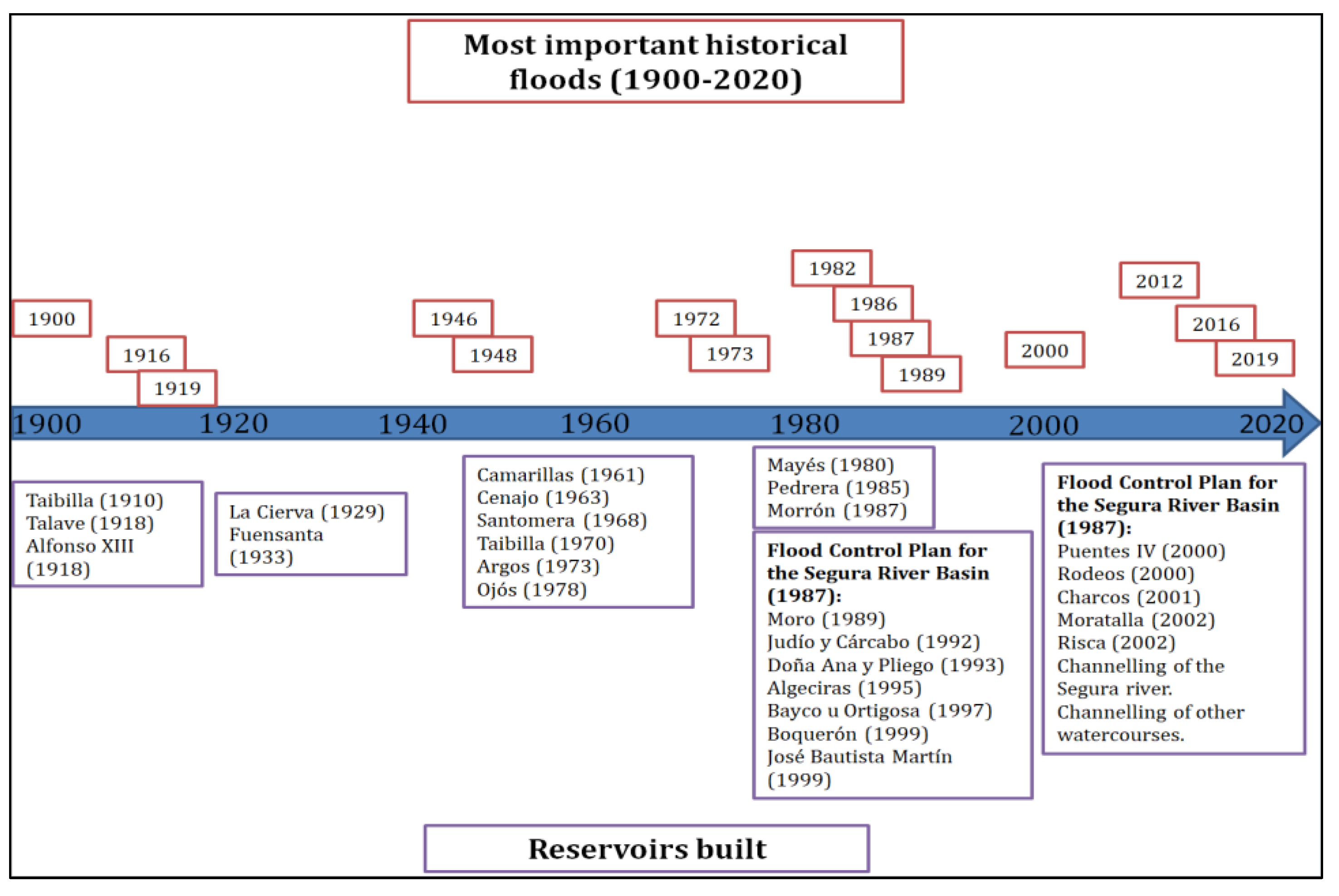
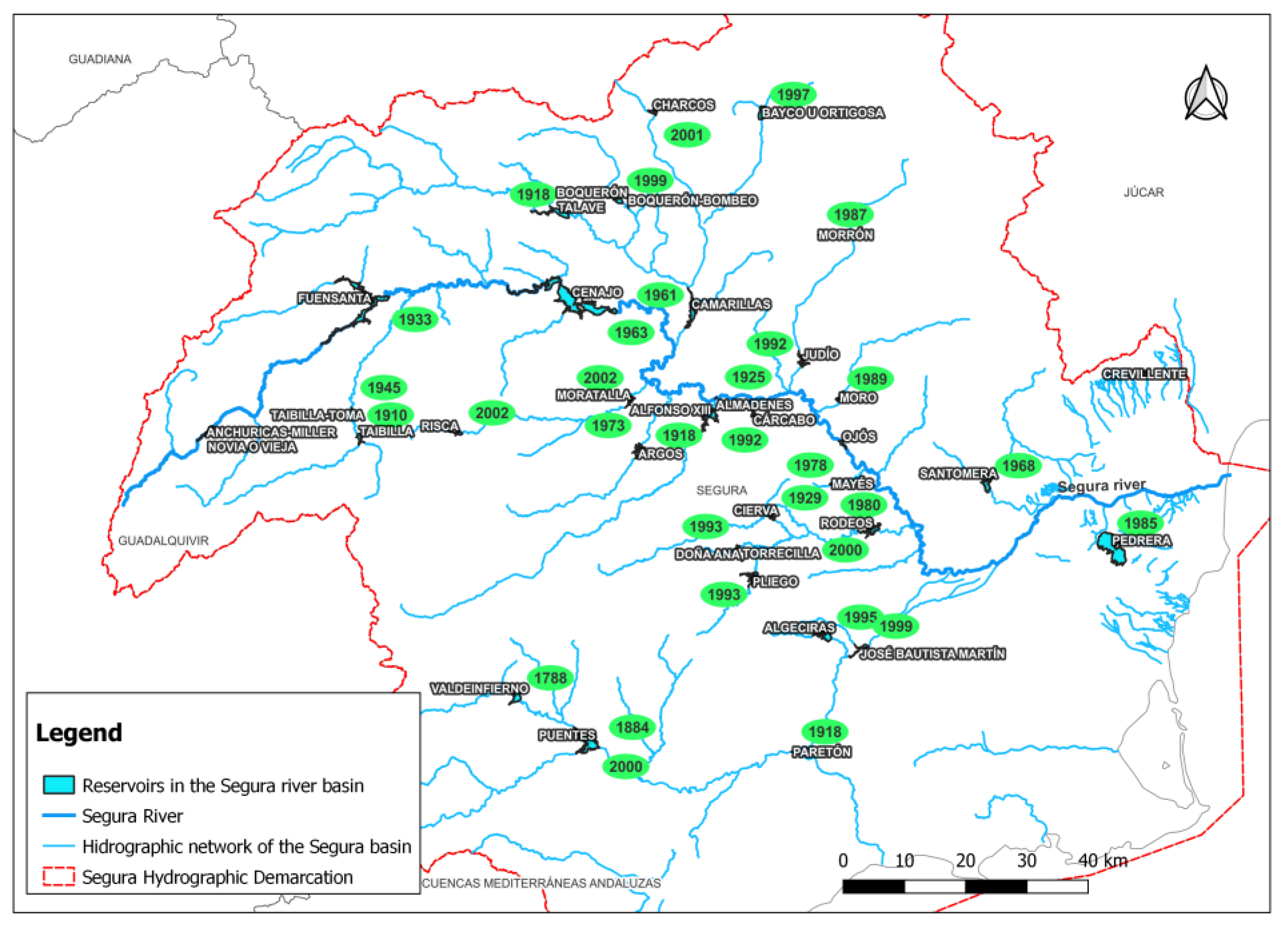
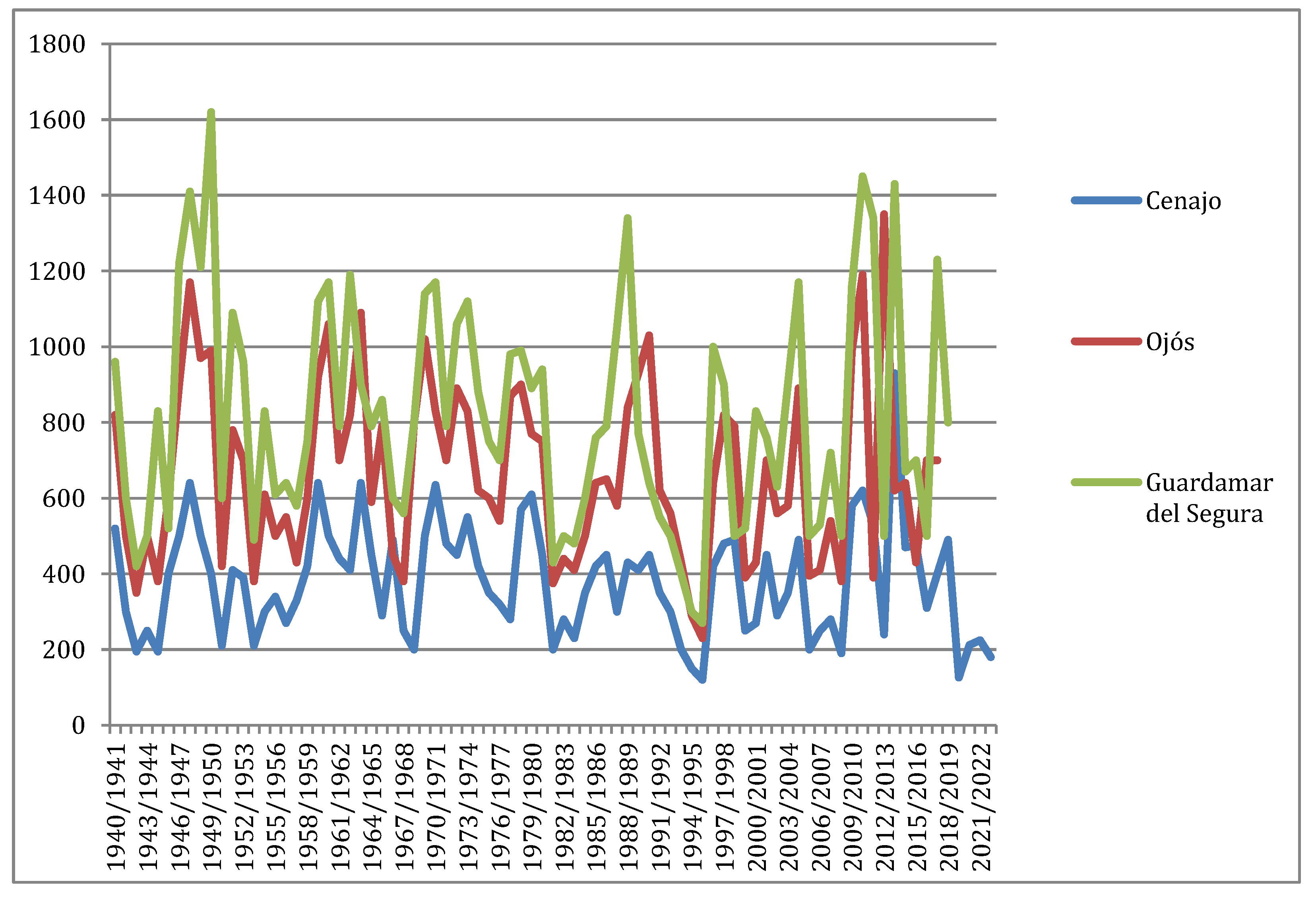
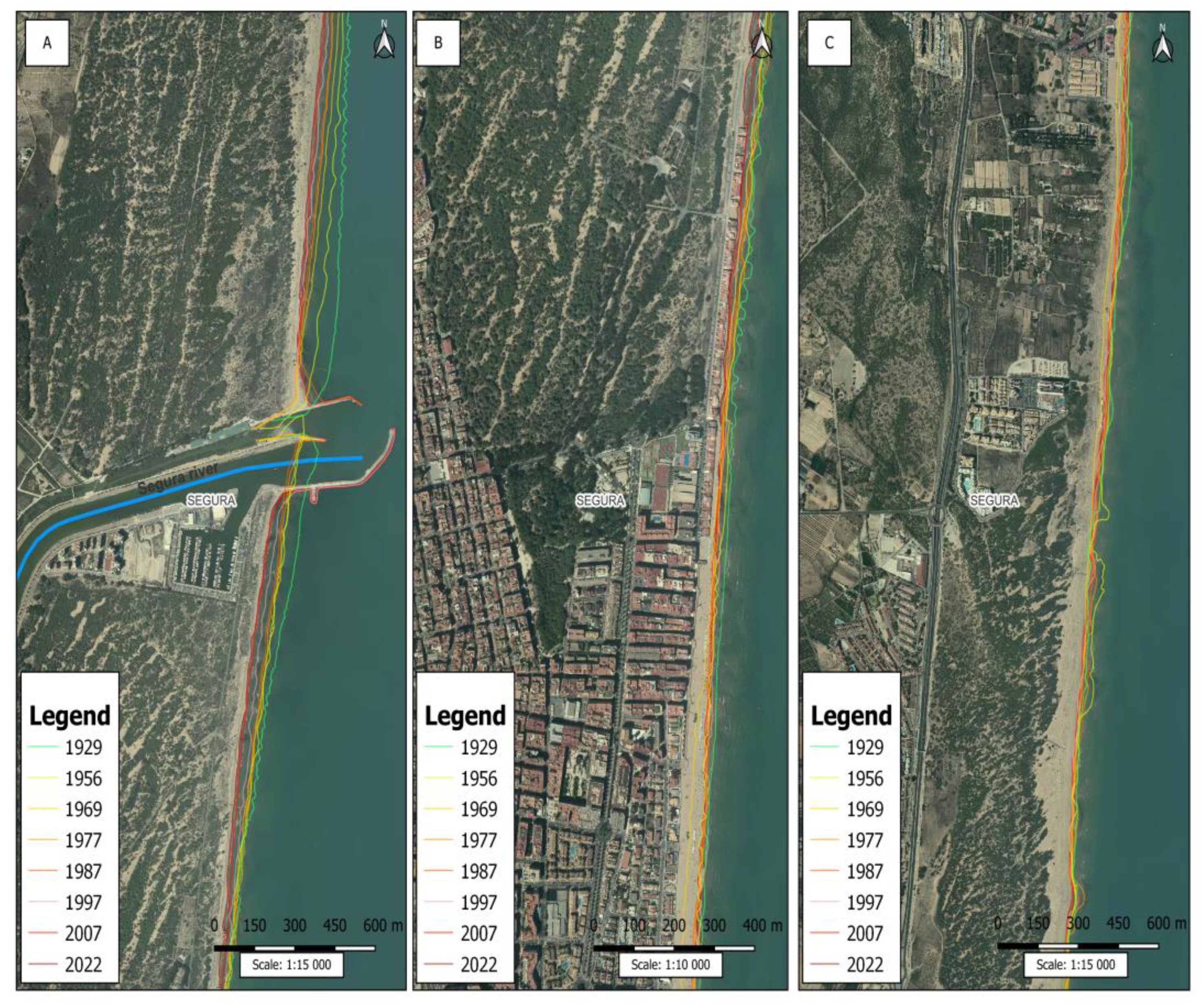
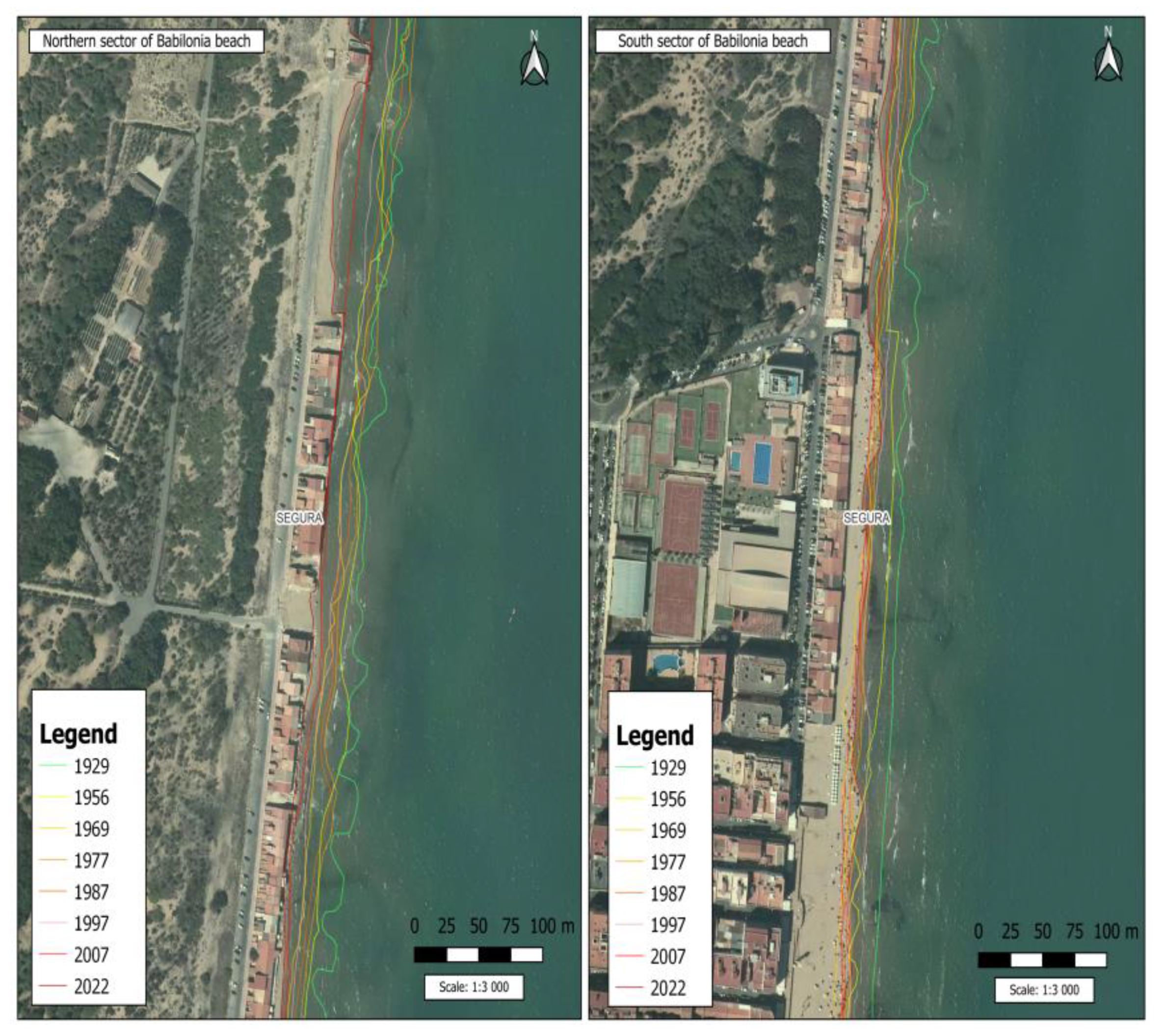
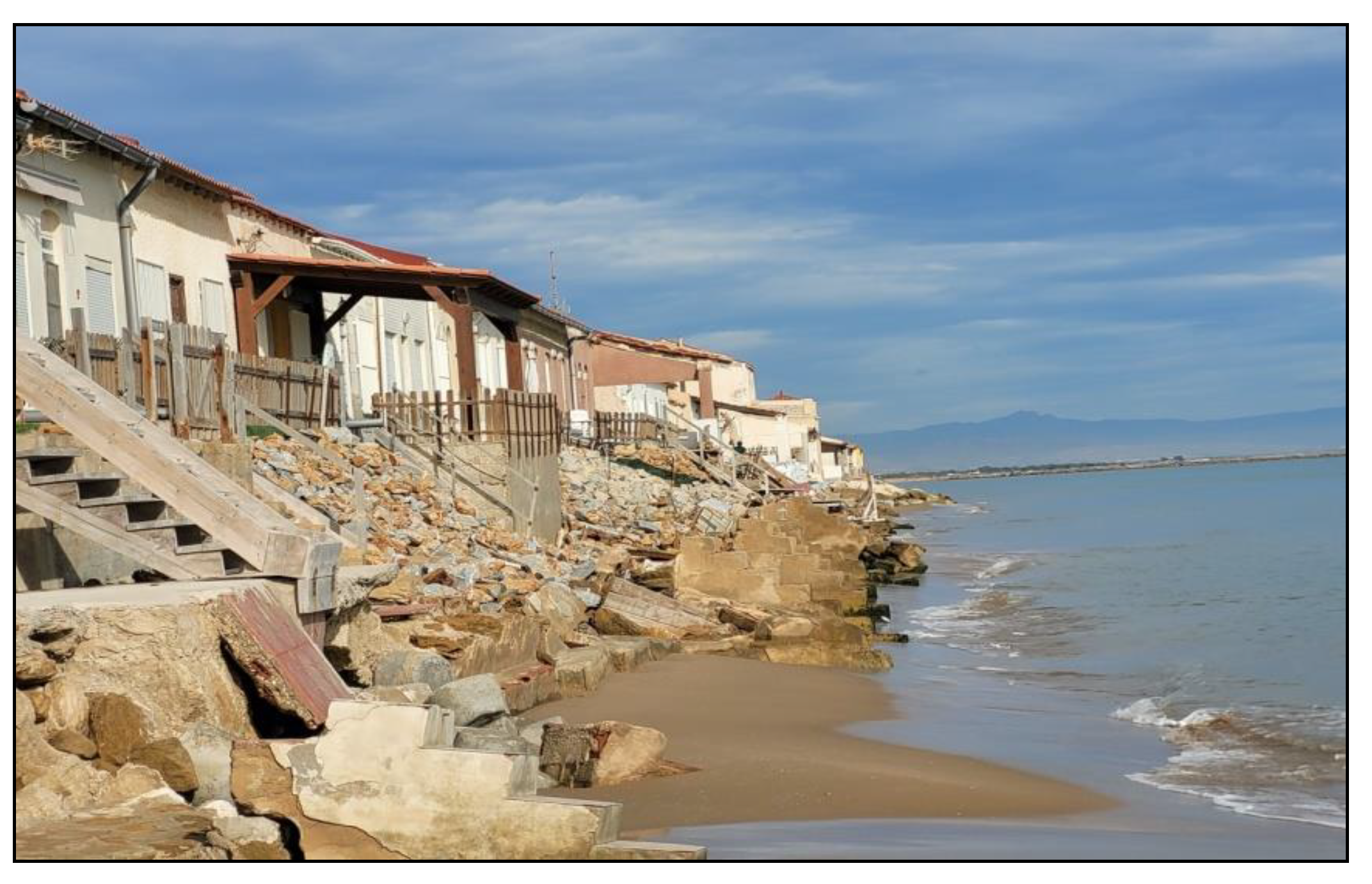
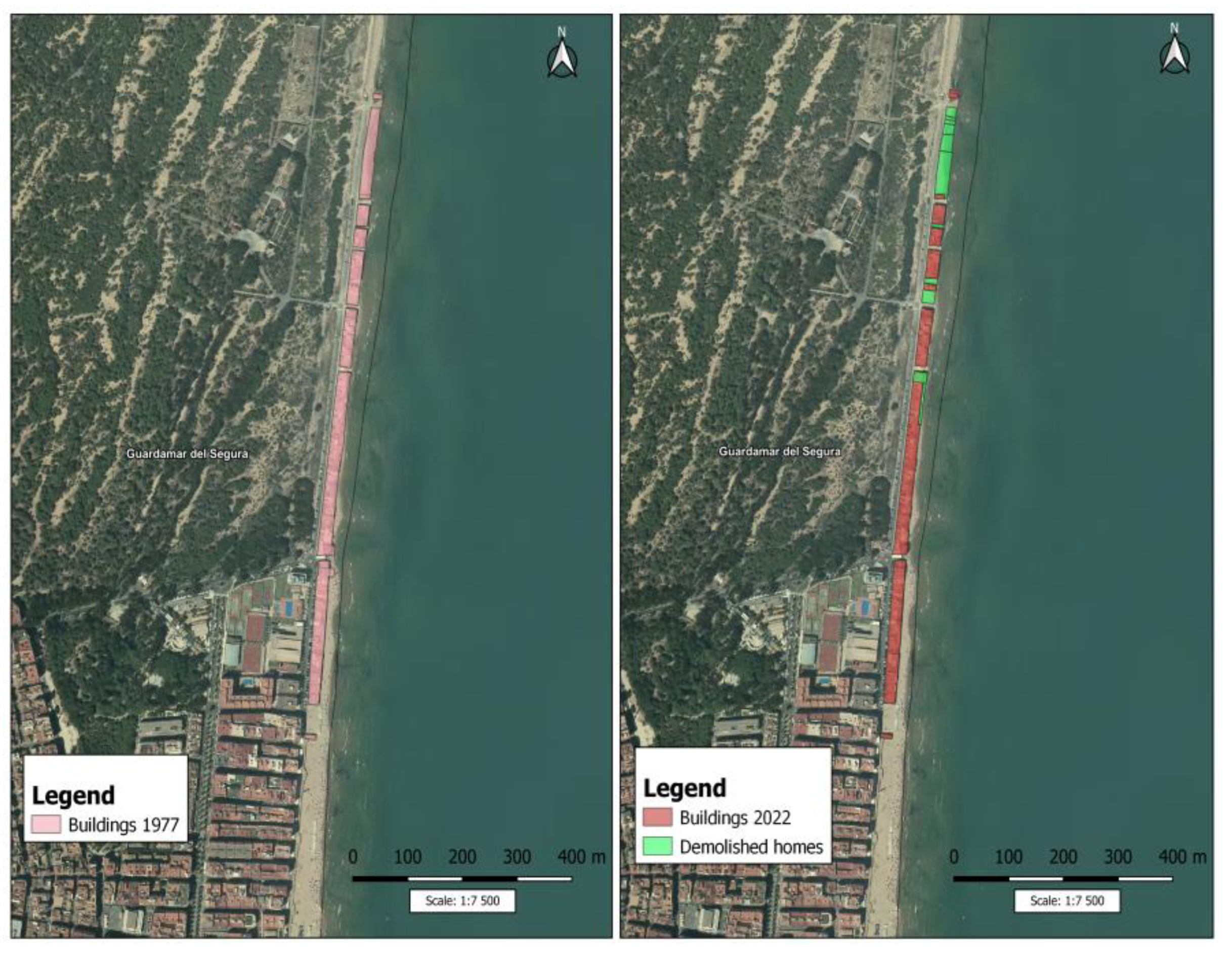
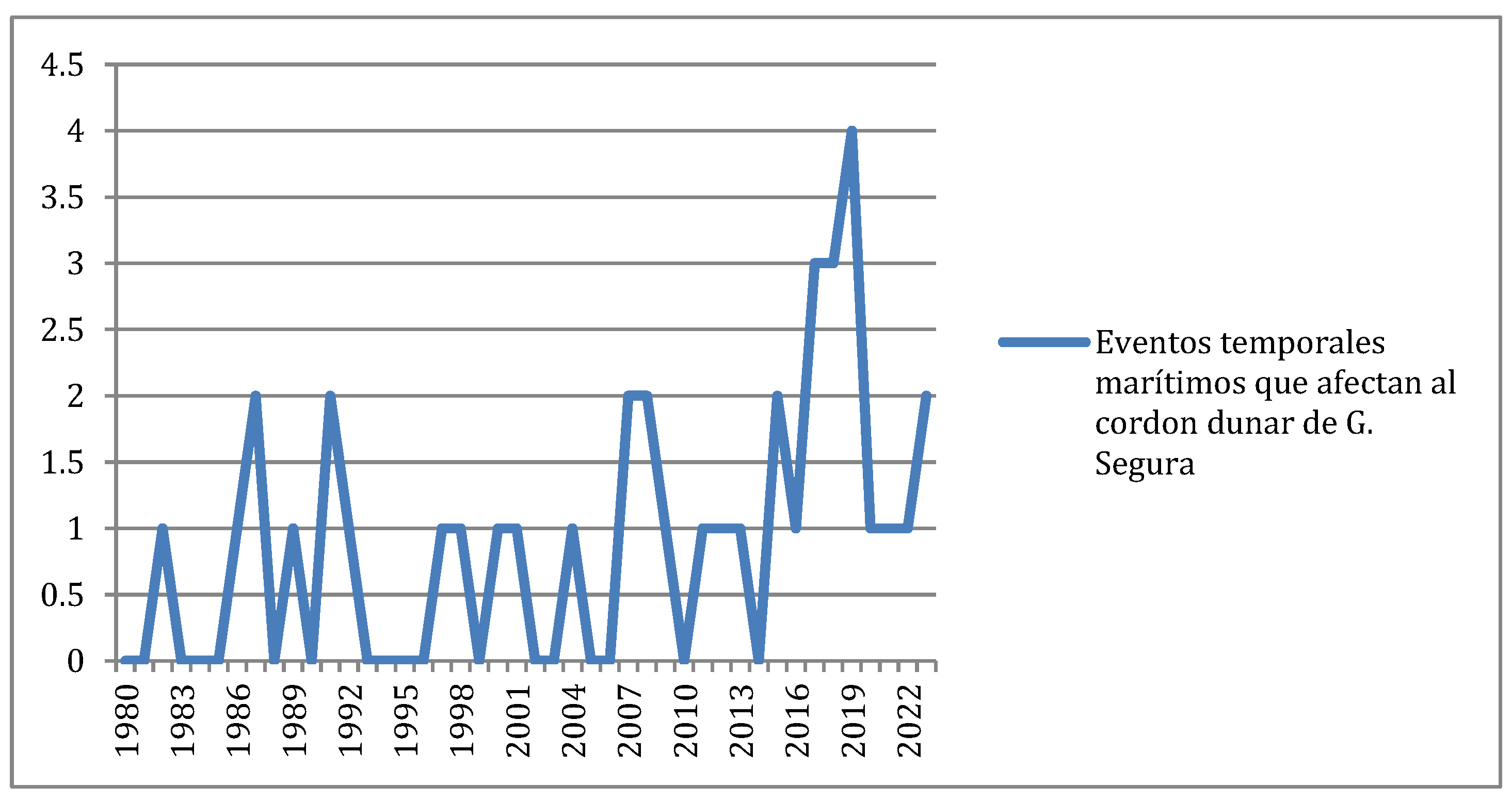
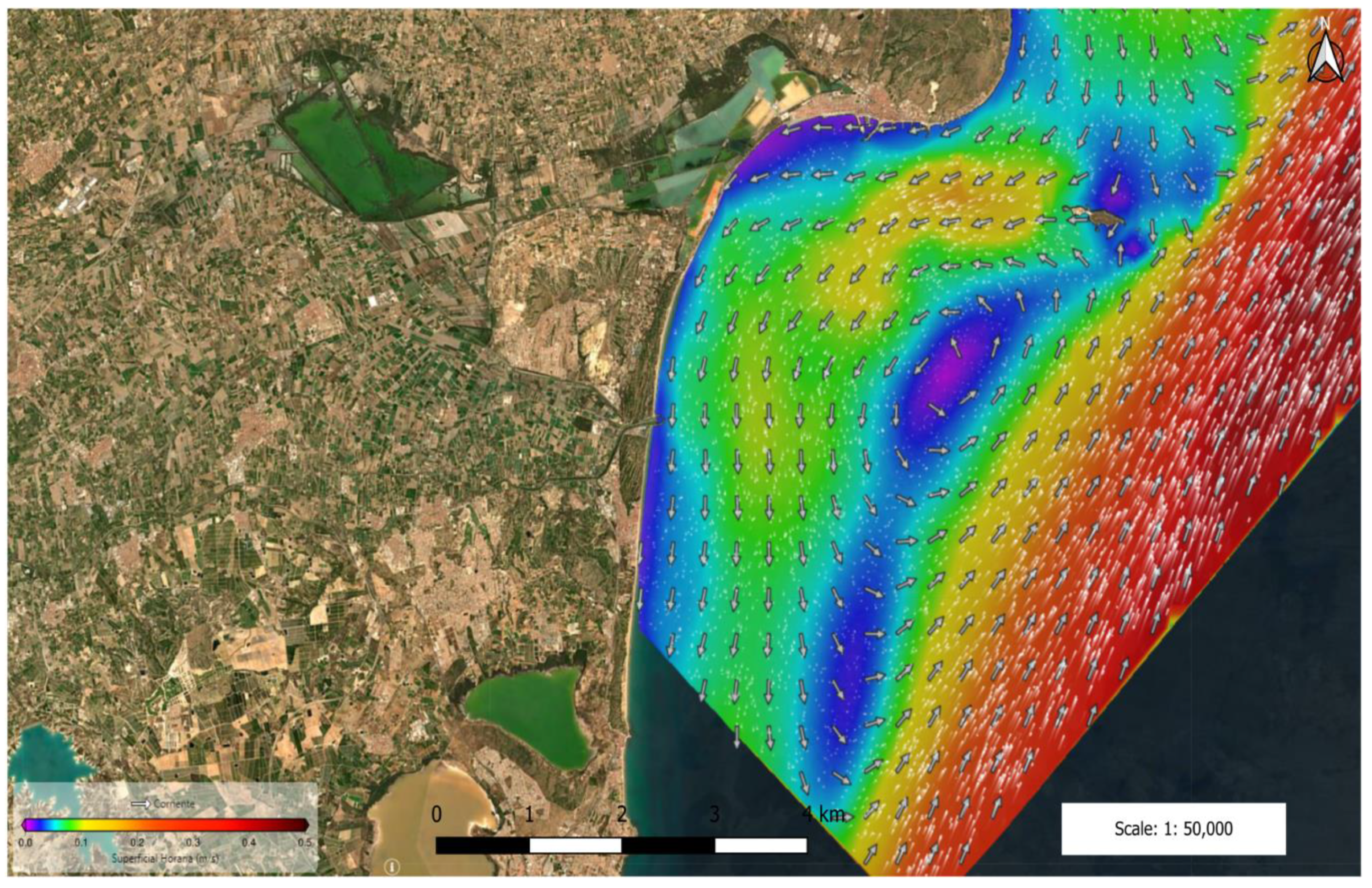
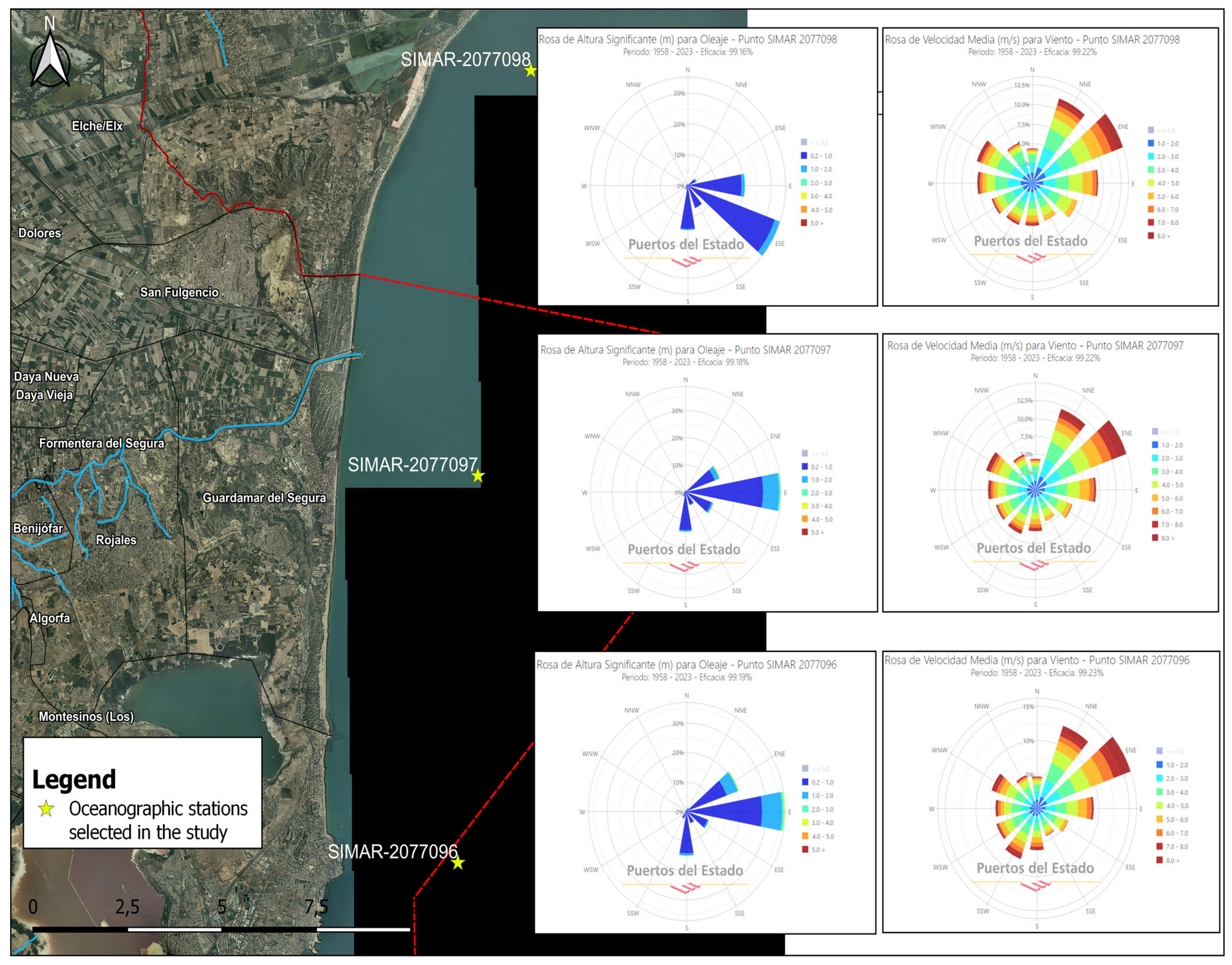
| Origin | Cause | Consequence | Results |
|---|---|---|---|
| Natural | Maritime storms | Naturally recoverable coastal retreat | Sediment accretion or accumulation zones and shoreline area reclamation |
| Storms on waterways | |||
| Anthropic | Sea level rise due to climate change | Coastal retreat not recoverable | Coastal retreat not recoverable |
| River basin regulation | Sediment reduction | ||
| Land use changes in river basins | Sediment reduction | ||
| River-defence hydraulic works and alluvial material extractions | Sediment reduction | ||
| Coastal-defence hydraulic works | Break in coastal drift | ||
| Urban development in coastal areas | Coastal retreat | ||
| Wind disturbance | |||
| High economic losses | |||
| Risking human lives |
| Segura River Basin | |||
|---|---|---|---|
| Rivers | Reservoirs | Project Reservoir Capacity (hm3) | Total Reservoir Capacity (hm3) |
| Guadalentín | Valdeinfierno | 21 | 11.16 |
| Puentes IV | 29.3 | 29.3 | |
| Algeciras | 42.3 | 42.13 | |
| José Bautista Martín | 5.5 | 5.5 | |
| Segura | Alfonso XII | 22 | 23 |
| Fuensanta | 210 | 224.7 | |
| Cenajo | 437 | 465.59 | |
| Santomera | 26.69 | 26.62 | |
| Taibilla | 9.5 | 9.5 | |
| Argos | 8.07 | 8.07 | |
| Ojós | 3 | 2.8 | |
| Mayés | 1.5 | 1.5 | |
| Pedrera | 246.7 | 246.9 | |
| Moro | 7.07 | 7.07 | |
| Judío | 9 | 9 | |
| Cárcabo | 2.79 | 2.79 | |
| Moratalla | 5 | 5 | |
| La Risca | 3.17 | 3.17 | |
| Mundo | Talave | 35 | 39.11 |
| Camarillas | 38.63 | 38.63 | |
| Los Charcos | 4 | 2 | |
| Bayco u Ortigosa | 9 | 9 | |
| Boquerón | 13 | 12 | |
| Mula | Cierva | 5 | 7.28 |
| Morrón | 0.07 | 0.03 | |
| Doña Ana | 2.54 | 2.36 | |
| Pliego | 8.91 | 8.00 | |
| Rodeos | 15.01 | 14.50 | |
| TOTAL | 1120.75 | 1256.71 | |
| Recent Episodes of Major Floods in the Segura River Basin | |||||||||
|---|---|---|---|---|---|---|---|---|---|
| River | Gauging Stations | September 1997 (m3/s) | February 1999 (m3/s) | October 2000 (m3/s) | October 2003 (m3/s) | October 2006 (m3/s) | September 2012 (m3/s) | December 2016 (m3/s) | September 2019 (m3/s) |
| Segura River | 04A06—La Graya | N/A | N/A | N/A | N/A | N/A | N/A | N/A | N/A |
| 04A04—El Gallego | N/A | N/A | N/A | N/A | N/A | N/A | 10.742 | 36.457 | |
| 03A03—Calasparra | N/A | N/A | N/A | N/A | 6.903 | 28.669 | 30.336 | 69.587 | |
| 02R01—Cieza | 69.943 | 31.716 | 29.092 | 34.647 | 14.638 | 56.254 | 29.536 | 107.581 | |
| 02A04—Blanca | N/A | N/A | N/A | N/A | N/A | 63.153 | 34.697 | 192.949 | |
| 02A02—Ojós | 36.847 | 3.866 | 3.06 | 5.94 | 2.316 | 35.957 | 8.465 | 173.918 | |
| 01A01—Contraparada | 174.92 | 59.234 | 107.519 | 596.477 | 2.499 | 101.087 | 140.988 | 267.176 | |
| 07R02—Alquerías | N/A | N/A | N/A | N/A | 1.56 | 122.267 | 170.154 | 183.544 | |
| 07A06—Orihuela | N/A | N/A | N/A | N/A | N/A | N/A | N/A | 111.454 * | |
| 07R04—Benejúzar | N/A | N/A | N/A | N/A | 92.587 | 85.288 | 117.483 | 173.715 | |
| 07R06—Rojales | N/A | N/A | N/A | N/A | N/A | 75.919 | 90.565 | 125.852 | |
| Mundo River | 03A05—Liétor | N/A | N/A | N/A | N/A | N/A | N/A | 3.646 | 20.967 |
| 03A04—Azaraque | N/A | N/A | N/A | N/A | N/A | N/A | 13.378 | 16.182 | |
| Mula River | 01O03—Albuidete | 150.442 | 71.758 | 43.451 | 653.049 | 723.045 | 137.396 | 70.514 | 157.954 |
| Guadalentín River | 01O05—El Palmar (Murcia) | N/A | N/A | N/A | N/A | N/A | N/A | N/A | N/A |
| 1929–1930 | 1956 | 1987 | 2000 | 2023 | |||
|---|---|---|---|---|---|---|---|
| Guardamar del Segura | Northern coastline in relation to the mouth of the Segura River | Los Tusales Beach | 159 m | 102 m | 31.3 m | 23.4 m | 12.5 m |
| Mouth of the Segura River | Mouth of the Segura River | 90.8 m | 55.5 m | 41.6 m | 8.3 m | 2 m | |
| Southern coastline in relation to the mouth of the Segura River | Guardamar dunes | 96.4 m | 54.9 m | 30.2 m | 21.8 m | 5.2 m | |
| Babilonia Beach | 96.4 m | 55.6 m | 44.3 m | 32.1 m | 0 m | ||
| Centro Beach | 120 m | 73 m | 62.1 m | 55.6 m | 41.3 m | ||
| Las Ortigas Beach | 101 m | 122.4 m | 102.7 m | 124.3 m | 57.7 m | ||
| Data on regulatory works in the Segura Basin | Valdeinferno and Puentes III | Valdeinferno, Puentes III, Talave, Alfonso XII and Fuensanta | Valdeinferno, Puentes III, Talave Alfonso XII, Fuensanta, Cenajo, Camarillas, Santomera, Taibilla, Argos, Ojós, Pedrera and Morrón | Valdeinferno, Puentes III, Talave, Alfonso XII, Fuensanta, Cenajo, Camarillas, Santomera, Taibilla, Argos, Ojós, Pedrera, Morrón, Moro, Judío, Cárcabo, Doña Ana, Pliego, Algeciras, Bayco u Ortigosa, Boquerón, José Bautista Martín, Puentes IV, Rodeos, Charcos, Moratalla, Risca, Encauzamiento Segura and breakwaters at the mouth of the river | - | ||
| Year | Number of Dwellings | Total Built-Up Area (m2) |
|---|---|---|
| 1930 | 55 | 8533 |
| 1977 | 126 | 19,463 |
| 1997 | 126 | 19,463 |
| Year | Number of Dwellings | Total Built-Up Area (m2) |
|---|---|---|
| 1997–2005 | 1 | 131 |
| 2005–2012 | 14 | 2218 |
| 2012–2022 | 6 | 1003 |
| 2023 | 3 (in progress) | 425 (in progress) |
| Total | 24 | 3777 |
| Number of Dwellings | Total Built-Up Area (m2) | |
|---|---|---|
| Dwellings built | 126 | 19,463 |
| Demolished dwellings | 24 | 3777 |
| Total | 102 | 15,686 |
Disclaimer/Publisher’s Note: The statements, opinions and data contained in all publications are solely those of the individual author(s) and contributor(s) and not of MDPI and/or the editor(s). MDPI and/or the editor(s) disclaim responsibility for any injury to people or property resulting from any ideas, methods, instructions or products referred to in the content. |
© 2024 by the authors. Licensee MDPI, Basel, Switzerland. This article is an open access article distributed under the terms and conditions of the Creative Commons Attribution (CC BY) license (https://creativecommons.org/licenses/by/4.0/).
Share and Cite
Oliva, A.; Olcina, J.; Ollero, A. Coastal Retreat on the Spanish Mediterranean Coast in a Climate Change Context: Effects of the Regulation of the Segura River at Its Mouth and the Coastal Sand Dune in Guardamar del Segura (Alicante, Spain). Coasts 2024, 4, 63-88. https://doi.org/10.3390/coasts4010005
Oliva A, Olcina J, Ollero A. Coastal Retreat on the Spanish Mediterranean Coast in a Climate Change Context: Effects of the Regulation of the Segura River at Its Mouth and the Coastal Sand Dune in Guardamar del Segura (Alicante, Spain). Coasts. 2024; 4(1):63-88. https://doi.org/10.3390/coasts4010005
Chicago/Turabian StyleOliva, Antonio, Jorge Olcina, and Alfredo Ollero. 2024. "Coastal Retreat on the Spanish Mediterranean Coast in a Climate Change Context: Effects of the Regulation of the Segura River at Its Mouth and the Coastal Sand Dune in Guardamar del Segura (Alicante, Spain)" Coasts 4, no. 1: 63-88. https://doi.org/10.3390/coasts4010005
APA StyleOliva, A., Olcina, J., & Ollero, A. (2024). Coastal Retreat on the Spanish Mediterranean Coast in a Climate Change Context: Effects of the Regulation of the Segura River at Its Mouth and the Coastal Sand Dune in Guardamar del Segura (Alicante, Spain). Coasts, 4(1), 63-88. https://doi.org/10.3390/coasts4010005









